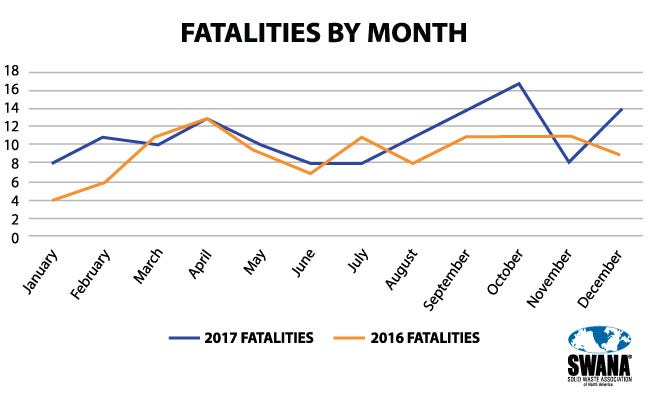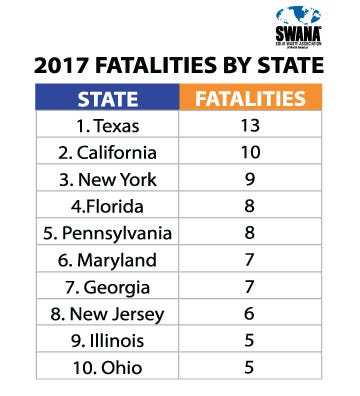SWANA Publishes 2017 Solid Waste Industry Fatality Data
The data reveals an 18 percent increase in fatalities from the year prior.

The Solid Waste Association of North America (SWANA) has released its 2017 solid waste industry fatality data, which reveals an 18 percent increase in total fatalities compared to 2016, with almost all incidents occurring in the U.S.
SWANA records and investigates fatal incidents that involve solid waste management as part of its mission, and it releases industry data to create a better understanding of the state of safety in the solid waste industry and where improvements are necessary.
In 2017, there were 132 recorded fatalities, 94 of which were members of the public and 38 of which were workers on the job. More than 75 percent of these incidents involved a private sector solid waste company.
October 2017 had the most fatalities at 17, though no month had fewer than eight. Compared to 2016, April had the most with 13 fatalities, and January had the least with four.
“I am disappointed in the waste industry’s safety performance in 2017 based on the fatality-related data that SWANA maintains,” said David Biderman, SWANA’s executive director and CEO, in a statement. “There were an unacceptable number of preventable fatal incidents involving our trucks and equipment.”

The majority of deaths involving a member of the public occurred on the roadways, with 60 percent involving a solid waste vehicle and at least one other vehicle. Sixteen of these cases involved the other vehicle crossing into the lane of an oncoming waste vehicle. Ultimately, there were 94 third-party fatalities: 57 were drivers of or passengers in other vehicles, 23 were pedestrians, eight were bicyclists, four were motorcyclists and two occurred at disposal facilities.
Of the 38 workers who died on the job in 2017, approximately 60 percent were killed during collection, 21 percent died at a landfill and the remainder occurred at material recovery facilities, transfer stations and other locations. A disproportionate number of these incidents involved small companies, usually haulers with fewer than 20 trucks. Half of the fatalities that occurred at landfills were drivers working on or around their trucks at the time of the incident, and two of them were spotters.

“We need to do a better job of communicating to frontline workers the importance of wearing safety belts while in the truck, lockout-tagout and backing carefully in order to mitigate the risk of preventable accidents,” said Biderman.
Consistent with previous years, solid waste workers died in a wide variety of ways, including being struck by their own truck, falling off the riding step and colliding with other vehicles on the road and equipment at disposal facilities. In four of the 37 fatal incidents, a collection worker was struck and killed by another vehicle.
These industry statistics are why SWANA supported recent efforts to pass Slow Down to Get Around (SDTGA) legislation in several states, including South Carolina, Kansas, Ohio and Maryland. Recently passed in Nebraska, 17 states now have SDTGA laws on the books.

The first two worker fatalities in 2017 were both in Maryland, including the death of City of Laurel employee Marcus Colbert. City of Laurel Mayor Craig Moe testified at the Maryland statehouse to help pass the state’s SDTGA bill, which is expected to be signed this spring.
“The City of Laurel was grateful and privileged to work with the Solid Waste Association of North America on Maryland’s new legislation; Motor Vehicles - Operation When Approaching Vehicle with Visual Signals will raise public awareness and provide a consistent message to motorists to pay attention to their surroundings to Slow Down to get Around,” said City of Laurel Mayor Moe in a statement. “This legislation will allow workers on our roadways to successfully complete their assignments safely and to return to their families at the end of the work day.”
SWANA embraces the goal of getting all workers home safely and urges industry professionals to use SWANA’s safety resources, including the “Five to Stay Alive” safety series, weekly Safety Monday mailings and safety events and trainings across North America, to move the solid waste industry off the federal government’s list of most dangerous jobs.
“The frequency of these incidents highlights how important safety needs to be for everybody in the industry, from the biggest companies down to the smallest haulers,” says Biderman. “SWANA will continue to partner with others and provide resources to get the collection side of the industry off the list of the 10 most dangerous jobs in the country. It’s clear to me that there’s a lot of activity in this space, but we have not, in my judgement, seen a reduction in fatalities commensurate with the level of activity, so we need to refocus and recommit to safety for the rest of this year and beyond.”
About the Author
You May Also Like


.png?width=300&auto=webp&quality=80&disable=upscale)